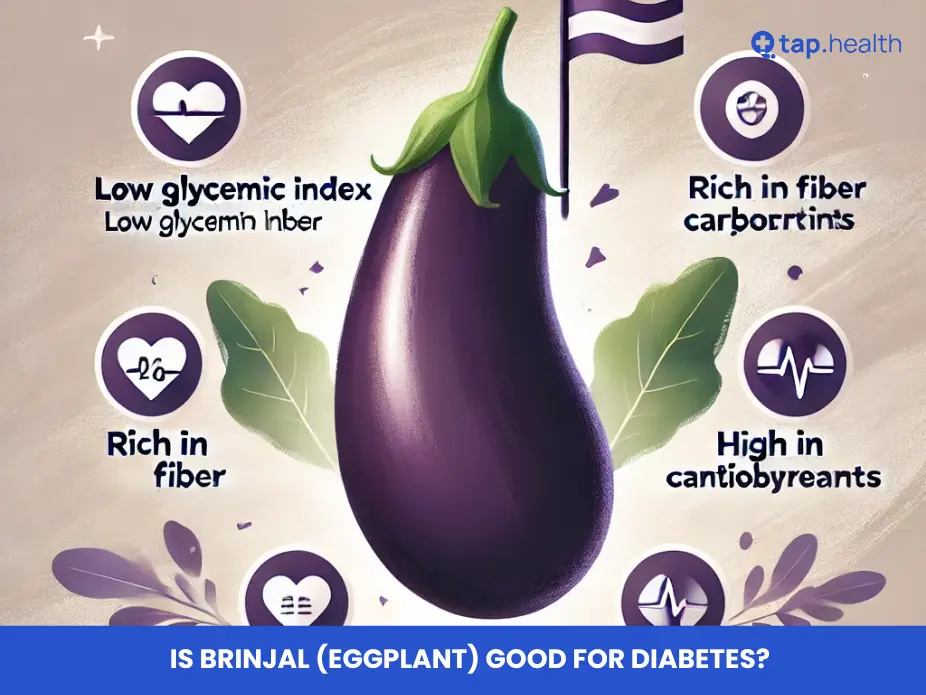Is Brinjal Good for Diabetes?
Managing diabetes effectively requires a strategic approach to diet, focusing on foods that help control blood sugar levels while providing essential nutrients. One vegetable that often piques interest in this context is brinjal, also known as eggplant. This comprehensive guide delves into whether brinjal is good for diabetes, exploring its nutritional benefits, impact on blood sugar, comparison with other vegetables, and practical tips for incorporating it into a diabetic-friendly diet.
Understanding Brinjal (Eggplant)
Brinjal, or eggplant, is a versatile vegetable belonging to the nightshade family. Known for its glossy purple skin and spongy flesh, brinjal is a staple in various cuisines worldwide, including South Asian, Middle Eastern, and Mediterranean dishes. Its ability to absorb flavors makes it a favorite ingredient in a multitude of recipes, from curries to grills.
Varieties of Brinjal
Brinjal comes in several varieties, each with unique characteristics:
- Purple Brinjal: The most common type, known for its deep purple skin and slightly bitter taste.
- White Brinjal: Features creamy white skin and a milder flavor compared to the purple variety.
- Green Brinjal: Smaller and more tender with a greenish hue.
- Striped Brinjal: Characterized by its striped skin, offering a blend of flavors.
- Indian Brinjal: Smaller and rounder, often used in Indian curries and stews.
- Red Brinjal: Contains additional antioxidants and has a reddish hue due to anthocyanins.
Nutritional Profile of Brinjal
Understanding the nutritional content of brinjal is crucial to assess its suitability for a diabetic diet.
Macronutrients
- Carbohydrates: Approximately 5 grams per 100 grams. Brinjal is low in carbohydrates, making it suitable for blood sugar control.
- Protein: Around 1 gram per 100 grams. While not a significant protein source, it contributes to overall intake.
- Fat: Less than 1 gram per 100 grams. Brinjal is virtually fat-free, beneficial for heart health.
Micronutrients
- Fiber: High in dietary fiber, with about 3 grams per 100 grams. Fiber aids in digestion and helps regulate blood sugar levels.
- Vitamins:
- Vitamin C: Supports the immune system and acts as an antioxidant.
- Vitamin K: Important for blood clotting and bone health.
- B Vitamins: Including B1 (thiamine), B6 (pyridoxine), and folate, essential for energy metabolism and red blood cell formation.
- Minerals:
- Potassium: Helps regulate blood pressure and fluid balance.
- Manganese: Involved in bone formation and metabolism.
- Magnesium: Supports muscle and nerve function, as well as blood glucose control.
Antioxidants
Brinjal contains powerful antioxidants like nasunin, found in its purple skin, which protect cells from damage caused by free radicals. Antioxidants play a vital role in reducing oxidative stress, a factor linked to diabetes complications.
Brinjal and Blood Sugar Control
For individuals with diabetes, maintaining stable blood sugar levels is paramount. Brinjal offers several properties that make it beneficial for blood sugar management.
Low Glycemic Index (GI)
Brinjal has a low glycemic index, typically around 20, which categorizes it as a low-GI food. Foods with a low GI cause a slower and more gradual rise in blood sugar levels, making them preferable for diabetics compared to high-GI foods that lead to rapid spikes.
High Fiber Content
The high dietary fiber in brinjal slows down the digestion and absorption of carbohydrates, leading to a more controlled release of glucose into the bloodstream. This helps in maintaining steady blood sugar levels and prevents sudden spikes that can be detrimental to diabetes management.
Rich in Antioxidants
Antioxidants like nasunin help reduce oxidative stress, which is often elevated in individuals with diabetes. Lower oxidative stress can improve insulin sensitivity and overall metabolic health, further aiding in blood sugar control.
Is Brinjal Good for Diabetes?
Yes, brinjal (also known as eggplant or aubergine) can be beneficial for people with diabetes. Brinjal is low in carbohydrates and high in fiber, which can help manage blood sugar levels. Here’s why it can be a good choice:
1. Low Glycemic Index
- Brinjal has a low glycemic index (GI), meaning it does not cause rapid spikes in blood sugar. Foods with low GI are ideal for people with diabetes as they release sugar slowly into the bloodstream, helping maintain steady blood sugar levels.
2. High in Fiber
- The fiber in brinjal slows down digestion, which can help regulate blood sugar by slowing the absorption of glucose. This reduces blood sugar spikes, making it a diabetes-friendly vegetable.
3. Rich in Antioxidants
- Brinjal is high in antioxidants like nasunin (found in the skin) and other polyphenols, which can help protect cells from damage and may improve insulin sensitivity, aiding in better blood sugar control.
4. Low Calorie Content
- Brinjal is low in calories, making it a great choice for weight management. Managing weight is particularly important for people with type 2 diabetes, as excess weight can affect insulin sensitivity.
5. Supports Heart Health
- People with diabetes are at a higher risk of heart disease, and brinjal contains compounds like anthocyanins that promote heart health by lowering blood pressure and improving cholesterol levels.
How to Include Brinjal in a Diabetes-Friendly Diet
- You can enjoy brinjal in a variety of ways, such as grilling, roasting, or sautéing. Avoid deep-frying, as this can add unnecessary fats and calories.
- Pair brinjal with other non-starchy vegetables and lean proteins for a balanced meal.
Precautions
- Although brinjal is generally healthy, some people with diabetes may be sensitive to nightshade vegetables (like brinjal, tomatoes, and peppers). If you notice any discomfort after eating brinjal, consult with your healthcare provider.
Benefits of Brinjal for Diabetic Patients
Incorporating brinjal into a diabetic diet can offer multiple health benefits:
- Blood Sugar Regulation: Low GI and high fiber content help stabilize blood sugar levels.
- Weight Management: Low in calories and high in fiber, brinjal promotes satiety, reducing overall calorie intake.
- Heart Health: Rich in potassium and low in sodium, brinjal helps maintain healthy blood pressure levels, reducing the risk of heart disease—a common complication of diabetes.
- Digestive Health: High fiber content aids in regular bowel movements and prevents constipation.
- Antioxidant Protection: Protects cells from oxidative damage, reducing the risk of diabetes-related complications.
- Bone Health: Contains vitamin K and magnesium, essential for bone strength and integrity.
- Versatility in Diet: Can be prepared in various healthy ways, making it easier to adhere to a diabetic-friendly diet.
Comparing Brinjal with Other Vegetables for Diabetes
When managing diabetes, selecting the right vegetables can significantly impact blood sugar control. Let’s compare brinjal with other popular diabetic-friendly vegetables.
Brinjal vs. Spinach
- Carbohydrates: Spinach has fewer carbohydrates compared to brinjal.
- Nutrient Content: Both are rich in fiber and vitamins, but spinach is particularly high in iron and calcium.
- Glycemic Index: Both have low GIs, making them suitable for diabetics.
Brinjal vs. Broccoli
- Fiber Content: Broccoli has slightly more fiber than brinjal.
- Nutrient Density: Broccoli is higher in vitamins C and K.
- Versatility: Both vegetables are versatile and can be included in various dishes.
Brinjal vs. Cauliflower
- Carbohydrates: Cauliflower has fewer carbohydrates than brinjal.
- Fiber and Protein: Cauliflower is comparable in fiber and slightly higher in protein.
- Low-Carb Alternatives: Cauliflower can be used as a rice or potato substitute for lower carb intake.
Brinjal vs. Zucchini
- Calories: Zucchini is lower in calories compared to brinjal.
- Fiber and Water Content: Zucchini has higher water content and slightly more fiber.
- Glycemic Index: Both have low GIs, suitable for diabetes management.
Conclusion
While all these vegetables are excellent choices for diabetics, brinjal stands out due to its unique flavor, versatility in cooking, and substantial nutritional benefits. Incorporating a variety of these vegetables ensures a balanced intake of nutrients and supports comprehensive diabetes management.
How to Incorporate Brinjal into a Diabetic Diet
Adding brinjal to your diet can be both delicious and beneficial for blood sugar control. Here are some practical ways to include brinjal in your meals:
1. Grilled Brinjal
Grilling brinjal slices with a drizzle of olive oil and your favorite herbs makes for a tasty and healthy side dish. Marinate the slices in lemon juice, garlic, and herbs before grilling to enhance flavor without adding excess calories.
2. Brinjal Stir-Fry
Combine brinjal with other non-starchy vegetables like bell peppers, onions, and spinach for a nutrient-packed stir-fry. Use minimal oil and season with spices for flavor. Adding tofu or lean chicken can increase the protein content, further stabilizing blood sugar levels.
3. Stuffed Brinjal
Fill brinjal halves with a mixture of lean ground turkey or chicken, vegetables, and spices. Bake until tender for a satisfying main course. Incorporate ingredients like tomatoes, onions, and garlic to boost flavor and nutritional value.
4. Brinjal Curry
Prepare a light brinjal curry using tomatoes, onions, garlic, and spices. Serve with a small portion of whole grains like brown rice or quinoa. Opt for low-fat coconut milk or yogurt to reduce calorie and fat intake while maintaining creaminess.
5. Roasted Brinjal
Roast brinjal cubes with a sprinkle of paprika and cumin for a flavorful addition to salads or as a snack. Roasting brings out the natural sweetness of brinjal and enhances its texture without the need for added fats.
6. Brinjal Soup
Blend roasted brinjal with vegetable broth, herbs, and spices to create a creamy and nutritious soup. This method preserves the fiber content while providing a warm and comforting meal option.
7. Eggplant Parmesan (Healthier Version)
Layer baked brinjal slices with low-fat cheese and marinara sauce for a diabetic-friendly version of the classic dish. Use whole-grain breadcrumbs and minimal cheese to keep the calorie and fat content in check.
8. Brinjal and Lentil Stew
Combine brinjal with lentils, tomatoes, and spices to make a hearty and protein-rich stew. Lentils add fiber and protein, which help in stabilizing blood sugar levels.
9. Pickled Brinjal
Quick-pickle brinjal slices with vinegar, spices, and a touch of natural sweeteners for a tangy condiment. Pickled brinjal can add a burst of flavor to salads and sandwiches without adding excessive carbohydrates.
10. Brinjal Pizza
Use roasted brinjal slices as a topping for homemade whole-grain pizza, paired with other vegetables and lean proteins. This adds a unique flavor and texture to the pizza while keeping it nutritious.
Cooking Tips for Diabetics Using Brinjal
Proper cooking methods can enhance the health benefits of brinjal while keeping it flavorful and appealing.
1. Limit Oil Usage
While brinjal absorbs oil easily, using minimal amounts helps keep the calorie and fat content low. Opt for heart-healthy oils like olive oil and use cooking sprays to control the amount of oil used.
2. Salt Moderation
Use salt sparingly to avoid excessive sodium intake, which can impact blood pressure. Enhance flavor with herbs and spices instead of relying on salt.
3. Baking vs. Frying
Baking or grilling brinjal is healthier compared to frying, as it reduces the need for added fats. These methods also help retain more nutrients compared to deep-frying.
4. Incorporate Herbs and Spices
Use a variety of herbs and spices like garlic, turmeric, cumin, and coriander to add flavor without extra calories or sodium. Fresh herbs like cilantro and parsley can also enhance taste and nutritional value.
5. Pair with Protein and Fiber
Combine brinjal with protein-rich foods and other high-fiber vegetables to create balanced meals that support blood sugar control. This combination slows down glucose absorption and promotes satiety.
6. Avoid Overcooking
Overcooking can break down the fiber content and increase the glycemic index. Cook brinjal until tender but still firm to maintain its nutritional benefits.
7. Pre-cook Preparation
Salting brinjal slices before cooking can reduce bitterness and excess moisture. Let them sit for 20 minutes, then rinse and pat dry before cooking to improve texture and flavor.
8. Use Non-Starchy Vegetables
Combine brinjal with other non-starchy vegetables to keep the meal low in carbohydrates and high in nutrients. This ensures a balanced intake of vitamins, minerals, and fiber.
9. Monitor Portion Sizes
Even with healthy cooking methods, it’s essential to keep portion sizes in check to manage carbohydrate intake effectively. Use measuring cups or a food scale to serve precise portions.
10. Experiment with Different Recipes
Trying various recipes keeps meals interesting and ensures you receive a range of nutrients from different cooking styles. Explore cuisines that traditionally use brinjal to discover new and exciting dishes.
Serving Sizes and Frequency for Diabetics
Understanding appropriate serving sizes and meal frequency is vital for effective diabetes management.
Recommended Serving Size
A standard serving size of cooked brinjal is about 100 grams (approximately one medium-sized brinjal). This portion provides roughly 25 calories, 5 grams of carbohydrates, and 3 grams of fiber, making it an excellent choice for a diabetic diet.
Frequency of Consumption
Brinjal can be included in daily meals, such as lunch and dinner, ensuring variety and balance in your diet. Incorporating it 2-3 times a week can provide consistent benefits without over-relying on any single food.
Balancing with Other Foods
Ensure that brinjal is part of a balanced meal that includes:
- Proteins: Lean meats, fish, tofu, or legumes.
- Healthy Fats: Olive oil, nuts, or avocado.
- Fiber-Rich Vegetables: Broccoli, spinach, or bell peppers.
- Whole Grains: Brown rice, quinoa, or barley in controlled portions.
Visual Portion Control Tips
- Use Measuring Cups: Measure brinjal servings to maintain consistency.
- Hand Portioning: A serving can be roughly the size of your palm.
- Plate Division: Allocate about one-quarter of your plate to brinjal, one-quarter to protein, and half to vegetables.
Potential Drawbacks of Brinjal for Diabetics
While brinjal offers numerous benefits, there are some considerations to keep in mind:
- Nightshade Sensitivity: Some individuals may be sensitive to nightshades, experiencing joint pain or digestive issues.
- Oxalates: Brinjal contains oxalates, which can contribute to kidney stone formation in susceptible individuals.
- Allergic Reactions: Although rare, some people may be allergic to brinjal, experiencing symptoms like itching, swelling, or difficulty breathing.
- Preparation Methods: Unhealthy cooking methods, such as deep-frying, can negate the health benefits of brinjal.
- Pesticide Residue: Non-organic brinjal may contain pesticide residues. It’s advisable to choose organic varieties or wash thoroughly before cooking.
Mitigation Strategies
- Choose Organic: Opt for organic brinjal to reduce pesticide exposure.
- Proper Preparation: Cook brinjal using healthy methods like baking, grilling, or steaming.
- Moderation: Consume brinjal in moderation, especially if you have a history of kidney stones or nightshade sensitivity.
- Allergy Awareness: If you suspect an allergy, consult with a healthcare provider before including brinjal in your diet.
Other Factors to Consider
When integrating brinjal into a diabetic diet, consider the following factors to maximize its benefits:
1. Overall Diet Quality
Ensure that brinjal is part of a high-quality, nutrient-dense diet. Avoid combining it with high-fat, high-sodium, or high-sugar foods that can undermine blood sugar control.
2. Variety in Vegetables
Incorporate a variety of vegetables to ensure a broad spectrum of nutrients and prevent dietary monotony. This also helps in obtaining different types of fibers and antioxidants.
3. Portion Control
Even healthy foods can impact blood sugar if consumed in large quantities. Always monitor portion sizes to stay within your carbohydrate limits.
4. Individual Health Conditions
If you have other health conditions, such as kidney disease or arthritis, consult with a healthcare provider to determine if brinjal is suitable for your diet.
5. Cooking Skills and Preferences
Choose recipes and cooking methods that you enjoy and can prepare consistently. This increases the likelihood of maintaining a balanced diet.
6. Arsenic Levels
Rice can contain trace amounts of arsenic, but brinjal is not a significant source. However, varying your grain intake and choosing organic produce can help minimize exposure to harmful substances.
Expert Opinions
Nutritionists and healthcare professionals generally support the inclusion of brinjal in a diabetic diet due to its low glycemic index and rich nutrient profile.
Dr. Emily Johnson, Registered Dietitian
“Brinjal is an excellent vegetable choice for individuals managing diabetes. Its low glycemic index and high fiber content help in controlling blood sugar levels effectively. Additionally, its versatility in various cuisines makes it easy to incorporate into daily meals.”
Dr. Michael Lee, Endocrinologist
“Integrating brinjal into a balanced diet can provide significant benefits for diabetes management. However, it’s essential to focus on overall dietary patterns and portion sizes to optimize blood sugar control.”
Research Insights
Studies have demonstrated that low-GI diets, which include vegetables like brinjal, can improve glycemic control and reduce the risk of diabetes-related complications. The antioxidants in brinjal also play a role in minimizing oxidative stress, which is linked to insulin resistance and other metabolic issues.
FAQ on Is Brinjal Good for Diabetes?
1. Can Brinjal Help in Lowering Blood Sugar Levels?
Yes, brinjal can help in lowering blood sugar levels due to its low glycemic index and high fiber content, which promote gradual glucose absorption and prevent blood sugar spikes.
2. How Often Should Diabetics Eat Brinjal?
Diabetics can include brinjal in their diet 2-3 times a week as part of balanced meals. Consistency and moderation are key to reaping its benefits without overconsumption.
3. What is the Best Way to Cook Brinjal for Diabetics?
The best ways to cook brinjal for diabetics include grilling, baking, steaming, or sautéing with minimal oil. Avoid deep-frying to keep it healthy and low in fat.
4. Are There Any Side Effects of Eating Brinjal for Diabetics?
While brinjal is generally safe, some individuals may experience digestive issues or have sensitivities to nightshades. It’s essential to monitor your body’s response and consult with a healthcare provider if you experience any adverse effects.
5. Can Brinjal Be Included in a Low-Carb Diet for Diabetes?
Yes, brinjal is suitable for low-carb diets as it is low in carbohydrates and high in fiber, making it an excellent choice for blood sugar management.
6. Is Organic Brinjal Better for Diabetics?
Yes, organic brinjal is preferable as it reduces exposure to pesticides and harmful chemicals, ensuring a healthier option for diabetic individuals.
7. How Does Brinjal Compare to Other Low-GI Vegetables?
Brinjal is comparable to other low-GI vegetables like spinach, broccoli, and cauliflower. It offers unique flavors and textures, making it a versatile addition to a diabetic diet.
8. Can Brinjal Be Part of a Weight Loss Plan for Diabetics?
Yes, brinjal is low in calories and high in fiber, which can promote satiety and support weight loss efforts—a crucial aspect of diabetes management.
9. Is Brinjal Safe for Pregnant Women with Gestational Diabetes?
Yes, brinjal is safe for pregnant women with gestational diabetes when consumed as part of a balanced diet. However, it’s essential to consult with a healthcare provider for personalized advice.
10. Can Brinjal Be Eaten Raw by Diabetics?
While brinjal can be eaten raw in salads, it is typically cooked to enhance its flavor and reduce bitterness. Cooking also helps break down certain compounds that may be harder to digest when raw.
Conclusion
Brinjal (eggplant) is a highly nutritious vegetable that offers numerous benefits for individuals managing diabetes. Its low glycemic index, high fiber content, and rich array of vitamins and minerals make it an excellent addition to a diabetic-friendly diet. Incorporating brinjal into balanced meals can aid in blood sugar control, support weight management, and promote overall health.
Key Takeaways
- Low Glycemic Index: Brinjal causes a gradual rise in blood sugar levels, making it suitable for diabetes management.
- High Fiber Content: Aids in digestion and stabilizes blood sugar by slowing glucose absorption.
- Nutrient-Rich: Provides essential vitamins, minerals, and antioxidants that support overall health.
- Versatile in Cooking: Can be prepared in various healthy ways to keep meals interesting and enjoyable.
- Moderation and Balance: Essential for maximizing benefits and preventing potential drawbacks.
Always consult with a healthcare provider or a registered dietitian to tailor your diet to your specific health needs and ensure that brinjal fits well within your overall diabetes management plan.



